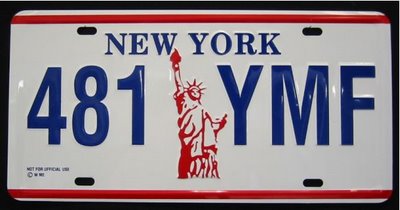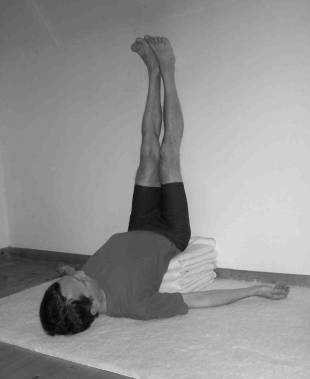You all haven't heard from me in quite a while. So much has been happening. I'm hoping to write a Daily Yoga Tip just to let you know what transpired since I wrote last.
But until then, I'm re-publishing something I wrote for Independence Day right after 9/11. I hope you like it.
It's longer than usual. So, hang in there to the end, if you can.
Here goes:
Try this pose with me. Stand comfortably with your feet about hip width apart. Raise your right arm over your head.
Make sure your arm is straight. Let your fingers be bent in a loose, comfortable fist. Point your right thumb up. With your left arm down at your side, put a little crook in the elbow so it is slightly bent. Stand erect and hold your head as if you are gazing far off at the distant horizon.
Do you recognize this pose? I haven’t seen it in any yoga books. If it were there, it might be called eka urdhva hastasana, the one hand up pose.
If this position doesn’t seem familiar to you from your yoga practice, teach it to someone else.
When you see your student do it, you’ll recognize it right away. It’s a pose that’s on the license plate of every car in New York.

Maybe the lyrics to this song will help you see it more clearly:
“In New York Harbor, stands a lady with a torch raised to the sky.Some of the positions we practice over and over, like viparita karani (see the picture) for example, are technically not asana (poses).
And all who see her know she stands for Liberty for you and me.”

They’re what the old yoga books call mudra.
There are two basic types of mudra: some you do with just your hands, some with your whole body.
You’re probably most familiar with anjali mudra, the hand gesture we practice at the end of every yoga class when we say namaste to one another.
 No matter where you are, this gesture of placing the palms together seems to have the same meaning. It’s an offering of reverence and respect.
No matter where you are, this gesture of placing the palms together seems to have the same meaning. It’s an offering of reverence and respect.Like poses, regular practice of these gestures can have profound effects on your body as well as your state of mind.
Many practice mudra as one component of their complete yoga discipline.
The word mudra in Sanskrit means seal. Think of your signature as your seal. It says, “This is who I am.”
Similarly, when a king presses his signet ring into the warm wax, it makes a document official.
Or think of a company logo. When you see that logo it stands for the products and services that you have come to expect. When you practice a mudra (with your hands or your entire body) it’s just like signing your name, it’s done intentionally, with purpose.
The idea behind a mudra is this: what you do with your body has meaning. It says who you are.
This idea is so simple and so prevalent in our day-to-day lives we hardly notice it.
When you say that someone “sat idly by and did nothing” you probably don’t mean that he was literally sitting the whole time. But the meaning of doing nothing is associated with the body position of sitting.
Likewise, when someone “takes a stand” on an issue you don’t mean that the person was physically standing.
Yet, standing has meaning.
Look again at the song lyrics above. They say, “she stands for liberty.” With her body, she represents the freedoms that are so much a part of American life.
When it comes to making a statement maybe there is no difference between asana and mudra.
Maybe every yoga pose is a symbol of who you are.
Every time you quiet your body in corpse pose, aren’t you saying something with your actions?
Every time you balance in tree pose, aren’t you making a statement?
Every time you bow forward in a standing forward bend, aren’t you expressing a value that you hold?
It must be. After all, despite the recent popularity of yoga practice, millions of people don’t practice it. They’re saying something (possibly different) with what they’re doing with their bodies.
“My poses are prayers,” said B.K.S Iyengar. Don’t you agree?
Some say the highest purpose of yoga is to still the chatter of the mind so that you can directly reacquaint yourself with your essence, so that you can hear your own inner voice, re-connect with the true you.
Why have we lost touch with ourselves? Because we are distracted by the things we can perceive with our senses, as if they are all that is. When you achieve the state of yoga, it is said, you can be free from the suffering that is unavoidably linked to a life limited to sense perceptions.
Liberation from the limitations of this life is called moksha in Sanskrit.
So when you join me in the posture I describe at the beginning of this article, let’s call it moksha mudra instead of eka urdhva hastasana. It, like every yoga pose you do, is a symbol of liberation.
More than two hundred years ago a group of men in Philadelphia took a stand for freedom. With their actions, with their words and deeds, they declared their own independence from tyranny and oppression.
It all began with a seal. They signed their John Hancocks on a document that sealed their fates and ours: The Declaration of Independence. They made themselves free by a stroke of the hand, a mere gesture, if you will, that turned the tide of history.
On September 11th we experienced probably the first real threat to that freedom that we’ve seen since Pearl Harbor. I would not have invited those events and the horrible tragedies that ensued. But I’m gratified and deeply moved by the sincere expressions of patriotism that I’ve seen since then.
Americans have been reminded of the value of freedom and the price that has been paid for it. I like it that I see American flags on nearly every car I pass on the road. It’s amazing to me that I can buy an American flag in nearly every gas station or convenience store I enter. It’s no longer corny to be patriotic!
Guess what? Nearly 18 million Americans are now doing yoga. It’s no longer corny to do yoga.
When I first started yoga some were quick to clue me in (and they still do) that sitting on the floor with my legs crossed qualified me as an odd ball.
The current yoga fad will fade soon enough; and so, sadly, will our visible expressions of national pride. While they’re with us, let’s extract from them their true essence, the best of what they have to offer.
Let this Independence Day be a special one. Feel your pride in our Country more strongly than ever. Join me in taking a stand for unity and freedom this summer. Take a stand. Make a gesture that says who you are. YOU ARE FREE!
Don't just read about it. Get up. Experience it. Experience yoga!
Kevin Perry
www.ExperienceYoga.org
p.s., The Sanskrit word of the day from my last Daily Yoga Tip is bhuja. Bhuja means arm or shoulder, as in eka hasta bhujasana, the one-hand shoulder pose.
p.p.s., Today's Sanskrit word of the day is kurma. I'll tell you what it means next time.
p.p.p.s, The meaning of seal when referring to mudra also applies to the flow of energy. Energy fluctuations in and around the body are very great at the "poles" of the body, the head, hands and feet. By forming the hands into various mudras, one shapes the energy flow and redirects it into the body to produce various effects.
p.p.p.p.s., Sallie and I are teaching the Experience Sanskrit workshop at Willow Street Yoga, in Silver Spring, Maryland one month from now, Saturday, August 5, at 1:00 pm. You can register online here. We hope to see you there!
p.p.p.p.p.s., Patriotism doesn't have to blind me to the truth. I love my country. But I know at the same time that not everything about it is admirable.
There's a bumper sticker I see on a van I walk by several times each week. It says, "God Bless All Nations." I really like it.
It challenges the "one slice of a pie" mentality that says we are competing for a limited pool of boons. For me and my family to have an advantage, you must be disadvantaged. Wrong.
Copyright 2006. All rights reserved, Mo Yoga LLC.
Kevin Perry
Mo Yoga LLC
1305 Elmerine Ave
Jefferson City, MO 65101
(573) 680-6737






No comments:
Post a Comment